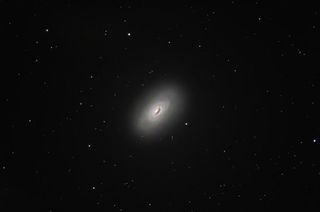In a race in opposition to the clock, earlier than the complete scene set beneath the horizon, astrophotographer Greg Meyer managed to seize this unimaginable picture of Comet 13P/Olbers zipping via house alongside The Black Eye Galaxy (M64).
“I had only one evening to seize this shot, and solely about 1 hour to do it. It was sinking quick beneath the horizon after sundown,” Meyer advised House.com in an e-mail.
On Aug. 25, Meyer was operating his telescope remotely, having positioned it on the Starfront Observatory situated close to Brady, Texas, simply six weeks prior. Your complete expertise was fairly new for Meyer. “I used to be shortly making adjustments on the fly in N.I.N.A. to border it and quickly seize sequential RGB utilizing my mono digital camera,” Meyer mentioned. His fast considering paid off and as a result of darkish skies on the Starfront Observatory, Meyer tracked down the comet to simply 12 levels above the horizon.
Comet 13P/Olbers is at the moment hurtling via the depths of our photo voltaic system and is nonetheless seen inside a pair of binoculars with a 40-50mm aperture or a small telescope, however hurry because it will not be round for for much longer. It made its closest strategy to Earth on July 20 when it got here inside 176 million miles (283 million kilometers) of our planet. Its subsequent shut strategy is not till 2094.
The comet is known as after German astronomer Heinrich Olbers, who found it in 1815. The “P” in its identify stands for “Periodic,” a label assigned to comets with orbits shorter than 200 years. The quantity 13 signifies that it was the thirteenth comet to be categorised as periodic.
Comet 13P/Olbers is not the one spectacular goal on this photograph.
Round 17 million light-years away within the constellation Coma Berenices (Berenice’s Hair) is a spiral galaxy, generally known as Messier 64, or the Black Eye Galaxy. Meyer caught this galactic scene alongside Comet 13P/Olbers on the evening of Aug. 25.

Within the picture you may make out the darkish band of mud that sweeps throughout one aspect of the nucleus, giving the Black Eye Galaxy its identify.
The galaxy has a wierd inside movement whereby the gasoline within the outer areas rotates in the wrong way from the gasoline and stars within the inside areas. The weird conduct is regarded as the results of a merger between M64 and one other galaxy over a billion years in the past.
For the “Tekkies”
Processing completed in Pixinsight , Photoshop, Lightroom
Location of Seize: Starfront Observatory, close to Brady, TX
Seize {hardware}:
- Esprit 120mm FL 840mm
- Digital camera: QHY 268M
- Mount: Ioptron CEM 70
- Focus: Moonlite focuser
- Guidescope Orion 60mm
- Acquisition: Eagle 4, NINA
You possibly can see extra of Meyer’s spectacular astrophotos through his astrobin account.
By no means miss an evening sky sight once more with our evening sky tonight web page and month-to-month skywatching calendar.
In the event you’re feeling impressed and need to set your sights on photographing the evening sky our astrophotography for freshmen and finest cameras for astrophotography guides could assist. Do you have to need a extra detailed view of the evening sky we’ve additionally rounded up a few of the finest telescopes for deep house.
Editor’s notice: In the event you seize a surprising photograph or video of the evening sky and need to share them with House.com for a potential story, ship pictures, feedback on the view and your location, in addition to use permissions to spacephotos@house.com.





